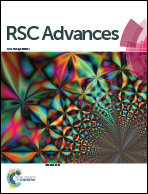Impact of strength and size of donors on the optoelectronic properties of D–π–A sensitizers†
Abstract
A series of carbazole based sensitizers with either phenyl based donors (TBC, TMC, OMC, PC, TBR, TMR, OMR and PR) or aryl amine based donors (OMNC, CNC and HNC) as well as one without a donor group (CC) have been synthesized to understand the influence of the strength of the donor moiety on the optical, electrochemical and photovoltaic properties. Two different acceptor moieties such as cyano acrylic acid and rhodanine acetic acid were introduced and evaluated. Different substituents on the phenyl group have a significant impact on the light harvesting ability of the sensitizers. Among phenyl based donors, anisole based carbazole (OMC) shows the highest short circuit current (JSC) of 4.96 mA cm−2 with overall power conversion efficiency (PCE) of 2.69%. In the case of the sensitizers with aryl amine based donors, the increasing bulkiness of the donor group lead to increasing open circuit potential. Transient photocurrent and photovoltage measurements signify the importance of a bulky donor fragment in determining the open circuit potential of the dyes. Sensitizers with hexyloxy substituted phenyl amine as the donor group shows a JSC of 6.84 mA cm−2 with PCE of 3.33%. The overall investigation provides vital information about the influence of donor groups on the optoelectronic properties of the sensitizers for its photovoltaic applications.



 Please wait while we load your content...
Please wait while we load your content...